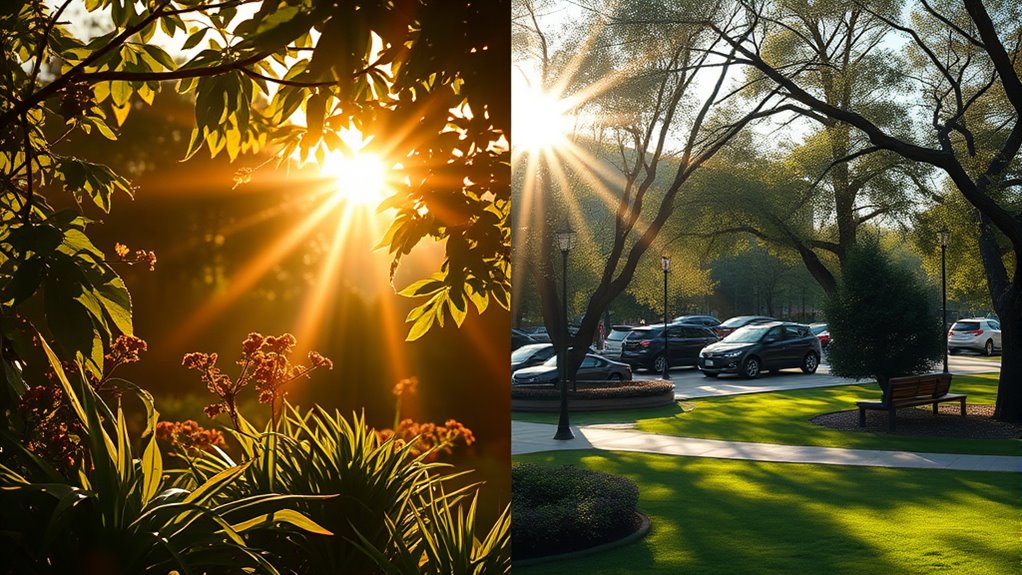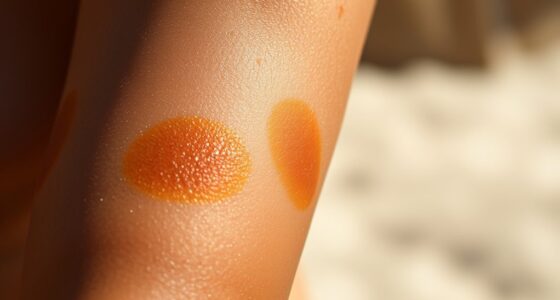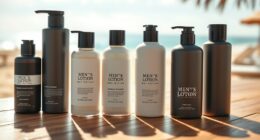Morning sun is generally safer because it provides vitamin D benefits with lower risk of skin damage, thanks to less intense UV rays. Spending extended time in any sun, whether morning or afternoon, can cause skin aging and increase cancer risk. If you stay outdoors for a short period early in the day, you gain health benefits safely. To understand how to maximize these benefits while protecting your skin, explore further tips below.
Key Takeaways
- Morning sun offers vitamin D benefits with lower skin damage risk due to less intense UV rays.
- Prolonged exposure in the morning increases skin damage and aging risks, even if rays are milder.
- Afternoon sun delivers more intense UV radiation, heightening skin cancer and damage risks with longer exposure.
- Protective measures like sunscreen and clothing are essential during both morning and afternoon sun to ensure safety.
- Moderation and timing are key; early morning sun is generally safer, but all outdoor exposure should be managed carefully.

The sun’s timing can considerably impact your daily routine and well-being, whether you prefer soaking up its early morning rays or enjoying the warmth of the afternoon sun. When it comes to health benefits, one of the most significant is vitamin D production. Your skin synthesizes this essential nutrient when exposed to UVB rays from sunlight. Morning sun exposure, typically before 10 a.m., tends to be gentler, providing enough UVB for vitamin D without the intense risk of skin damage. During these early hours, the sun’s rays are less intense, giving you a chance to boost your vitamin D levels safely. This can help improve your mood, strengthen your immune system, and support bone health, all without exposing your skin to the higher risks associated with midday or afternoon sun.
However, even during morning hours, you should still be mindful of skin damage. While the risk is lower compared to later in the day, prolonged exposure can still cause skin harm over time. Skin damage from UV rays manifests as premature aging, wrinkles, sunspots, and, more seriously, skin cancers. If you plan to spend extended periods outdoors in the morning, it’s wise to wear protective clothing, use broad-spectrum sunscreen, and seek shade when possible. This way, you can enjoy the benefits of sun exposure without risking long-term skin health.
In contrast, the afternoon sun often delivers more intense UV radiation, making it less ideal for prolonged exposure if you’re concerned about skin damage. The higher UV index during these hours increases the likelihood of harmful effects, especially if you forget to protect your skin. While afternoon sun can still help your body produce vitamin D, the associated risk of skin damage rises sharply. If you choose to enjoy sunlight later in the day, take extra precautions: apply a broad-spectrum sunscreen with high SPF, wear protective clothing, and limit your time outdoors. Remember, the goal is to balance the benefits of vitamin D synthesis with the risk of skin harm.
Ultimately, your safest bet is to get sunlight early in the day, when UV rays are less intense but still capable of stimulating vitamin D production. Even then, moderation and protection are key. By understanding the timing and risks, you can optimize your sun exposure to boost your health without compromising your skin’s integrity. Being aware of indoor versus outdoor exposure and their respective impacts can further help you make informed decisions about sun safety.
Frequently Asked Questions
How Does Sun Exposure Affect Skin Aging Differently in the Morning Versus Afternoon?
Sun exposure impacts skin aging differently in the morning versus afternoon due to UV damage and melanin production. In the morning, UV rays are milder, reducing your risk of premature aging, while afternoon sun exposes you to stronger rays, increasing UV damage. Your melanin production also varies, offering some natural protection earlier in the day. To protect your skin, try to limit prolonged exposure during peak hours and wear sunscreen.
Are There Specific Skin Types That Benefit More From Morning Sun?
If you have sensitive skin or a fair skin type, you benefit more from morning sun because it’s gentler and reduces risk of damage. Morning sun offers lower UV intensity, making it safer for those with high sun sensitivity. You should still wear sunscreen and protective clothing, but morning exposure minimizes skin aging and damage for vulnerable skin types, helping you enjoy the outdoors more safely.
What Are the Best Protective Measures During Peak Afternoon Sunlight?
During peak afternoon sunlight, you should wear protective clothing, like long sleeves and a wide-brimmed hat, to shield your skin. Seek shade whenever possible and avoid direct sun exposure during these hours. Applying broad-spectrum sunscreen with at least SPF 30 is essential. Remember to reapply every two hours, especially if you’re sweating or swimming. These measures help reduce your risk of sun damage and keep your skin safe.
How Does Vitamin D Synthesis Vary Between Morning and Afternoon Sun?
Vitamin D synthesis is more efficient during morning sun because sunlight intensity is lower, reducing your risk of skin damage while still allowing your body to produce vitamin D. In the afternoon, the stronger sunlight boosts vitamin D efficiency, but it also increases UV exposure, raising skin cancer risk. Thus, getting sunlight in the morning helps you balance vitamin D benefits with safety, making it the smarter choice for regular exposure.
Can Timing of Sun Exposure Influence the Risk of Skin Cancer?
Think of sun exposure as a double-edged sword—timing can tip the balance between skin health and risk. You’re safer when you catch morning or late afternoon sun, as UV rays are gentler, reducing skin cancer risks. Prioritize sun safety by protecting your skin during peak hours, wearing protective clothing, and applying sunscreen. These small steps help you enjoy the sun’s benefits without compromising your skin’s health or increasing cancer risk.
Conclusion
So, next time you’re debating whether to soak up the sun at dawn or during the afternoon, remember—morning sun is basically your superhero shield, fighting off wrinkles and skin villains before they even get close. Skipping the afternoon sun is like dodging a laser beam of UV rays that could turn you into a crispy, human toast! Choose your sun wisely—your future, less wrinkled self will thank you with a radiant, youthful glow!









